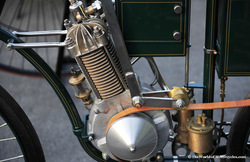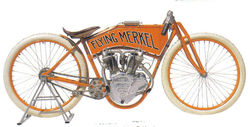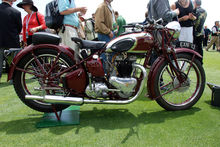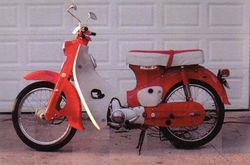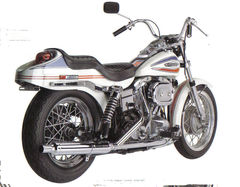(VIII) THE MACHINES WHICH INFLUENCED THE DIRECTION OF MOTORCYCLING!
Some of the most significant motorcycles in the history of the sport!
There are hundreds of motorcycles which have influenced the sport. Some with engine design, some with suspension innovations, some in terms of popularity, and others in terms of how they influenced other manufacturers. Some were small companies, some were large corporations, and in some cases, individuals alone had influence which far overshadowed their position in the industry. The machines listed on this page can certainly be debated as to their importance. These are just my picks! I am going to cover only a few of these ground breaking machines but may add pages in the future!
The first most significant development! The DeDion Bouton engine shown below:
This engine was built from the late 1890's till around 1903. It is so significant because it was used in hundreds of different motorcycle brands. It started as a 138cc engine producing about 1/2 hp and grew to nearly 200cc's and 1.75hp. It was used as the power source for many start up brands and was also copied by nearly "everyone" who built engines prior to 1905. Sold in Europe and brought to America (and copied), this little engine was the primary engine model behind the early motorcycle industry. It's significance to the history of the motorcycle can't be calculated!
THE SECOND MOST IMPORTANT MOTORCYCLE DEVELOPMENT! THE MERKEL MOTORCYCLE:
Sometimes known as the "Flying Merkel", this was one of the most progressive bikes of it's day. Unlike most other manufacturers, this company was about innovation more than profits. The Merkel was far ahead of it's time and continued to have influence decades after they were gone. They were one of the first to have a transmission, an OHV engine, an actual suspension system, electric starting, oil in the frame, and a kickstarter. The Merkel represents serious innovation which influenced the industry far beyond it's market position. The Merkel was the race bike to beat, known as very reliable, and led in development. The Merkel lasted from 1902 till 1915.
THE THIRD MOST SIGNIFICANT MOTORCYCLE DEVELOPMENT; THE 1937 TRIUMPH SPEED TWIN:
Edward Turners Triumph Speed Twin of 1937 was one of the most significant machines developed in the history of motorcycling. The influence of this vertical twin engine went beyond Britian, but around the world including Japan and America. Within a decade, nearly every British motorcycle manufacturer had made their own version of this engine. This basic bike led the motorcycle industry for nearly 40 years. Again, the influence of this bike can not be estimated!
NUMBER FOUR IN IMPORTANCE, THE HONDA REVOLUTION:
Pictured above is William Brown's 1967 Honda C100 (Cub 50). The Cub was first sold in 1958 and brought to America in 1959. The Cub is the worlds best (yes best) selling vehicle ever, passing 60,000,000 units sold last year. In 1964 Honda offered, along with the 50cc model, a 65cc and 90cc model. The little Cub had updates in 1967, the early 1980's and more in the 1990's, none however, changing the basic design very much. The Honda revolution began with the Cub, continued with the Hawk and Super Hawk models, the 250/305 Scramblers were huge sellers, opened a new market with the CB750, again broke new ground with the flat four (Goldwing), again with the V-4's (VFR's), also with the oval piston race bikes (NS series) and now with the new VFR1200, twin clutch automatic. Honda has had more "firsts" than any other brand of motorcycle, period. There is no question, Honda changed the world of motorcycling in a dramatic way!
NUMBER FIVE IN TERMS OF INFLUENCE & IMPORTANCE! THE 1971 HARLEY DAVIDSON SUPER GLIDE:
Before the Super Glide was offered as a new model, Harley Davidson had already been the motorcycle of choice for customizers for decades. The looks, the sound, and the history of the motorcycles were the reasons they were popular among the customizers. What the Super Glide did was this, it looked back over 30 years to the style of the American bikes of the 1950's and before. Some place importance on the 1977-78 XLCR Cafe Racer which was a low production special (about 3,000 made). The XLCR, however, attempted to compete with the modern performance bikes and it did not do so at all! What the Super Glide did was this, it was the first (?) factory custom offered by a major manufacturer as a standard model, secondly, it became the bike to customize (some say it fathered the modern Fat Boy), thirdly, it looked forward to the huge popularity of the "cruiser" market today (estimated 60% of the American market), and finally, it became the model which greatly influenced the next 30 years of Harley production. The early Super Glide defined a huge past, present, and future market in the world of motorcycling, this can not be disputed!
THE SIXTH MOST IMPORTANT MOTORCYCLE: THE 1992-1995 BRITTEN V 1000:
John Britten built his motorcycle from passion, not profits, pride, or duplicating what others had done before him. He began with the determination to have "no constraints" placed on his design, but to simply build the best. His story is like that of a modern day Crocker (very limited edition racing motorcycle built in the late 1930's) or similar to an Eric Buell who attempted to do much the same (but had the limitation of using Harley engines till he used a Rotax powerplant and became competitive). From very limited resources, John Britten built a world beater motorcycle which had innovations which the big boys copied and continue to use. He initiated the use of composite materials (including the main frame), used great innovation in engine design (also as a part of the frame), used an innovative front shock (for the back suspension), initiated engine data logging, used innovation in creating a very light super bike (303lbs. for a litre bike fully oiled and fueled), and created a super light composite "girder" type front fork. Above all else, John inspired the best and has become a legend in modern motorcycle innovation. He was also named one of the leading motorcycle innovators of the century as well as winning numerous other engineering awards. How incredable this is considering he died early of cancer in 1995, having a career in motorcycle building of just short of a decade!
